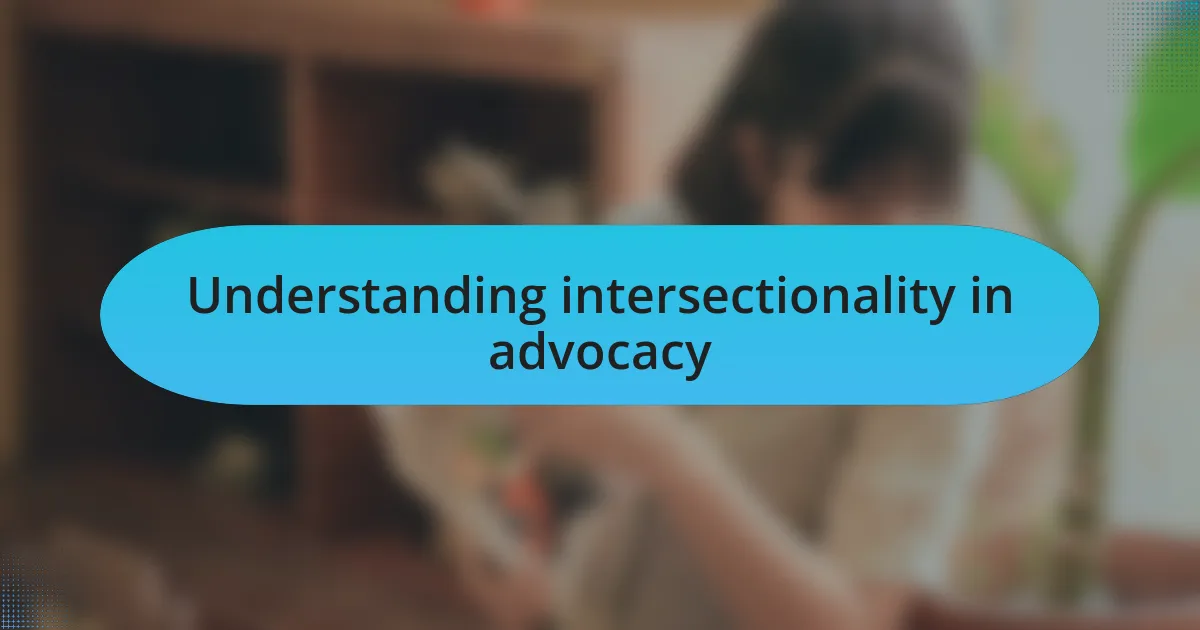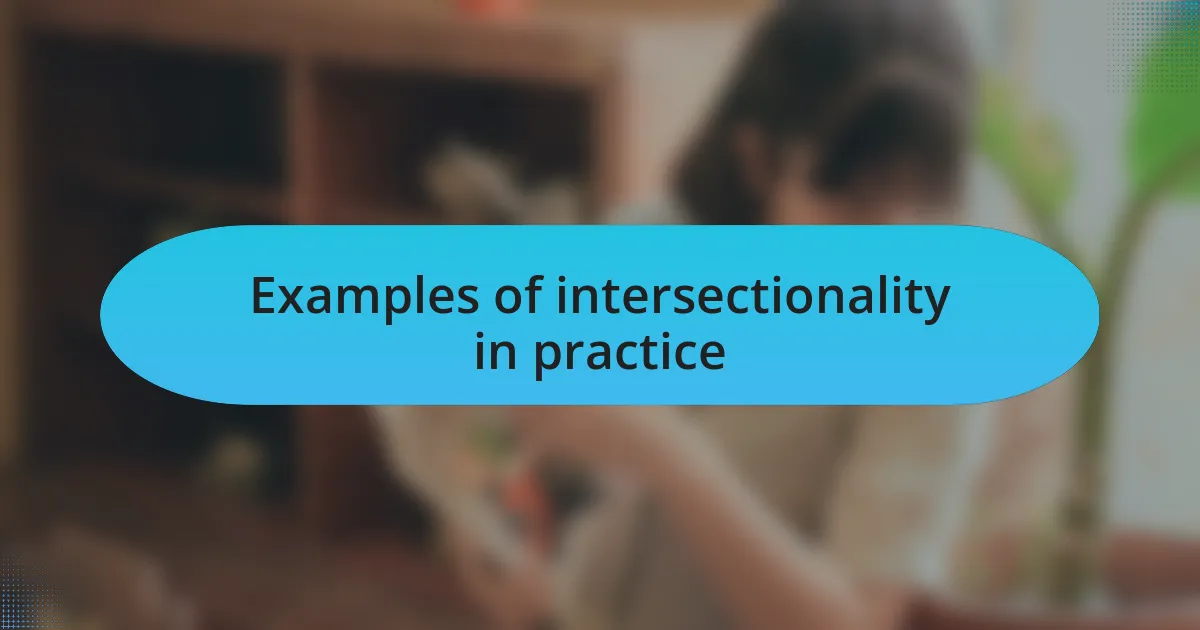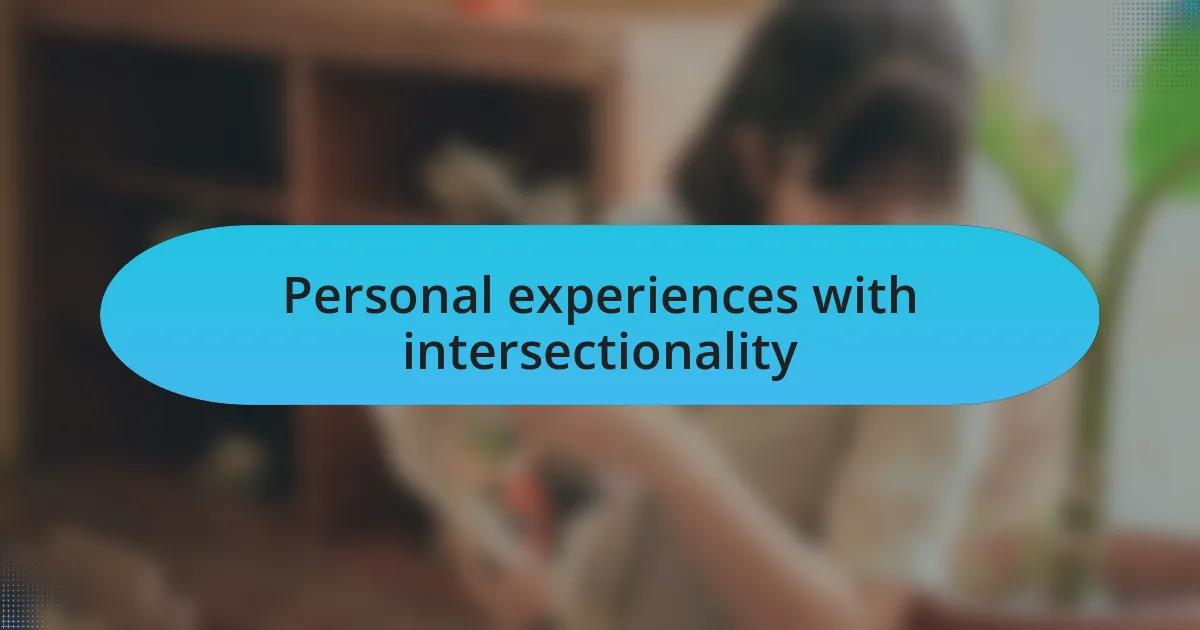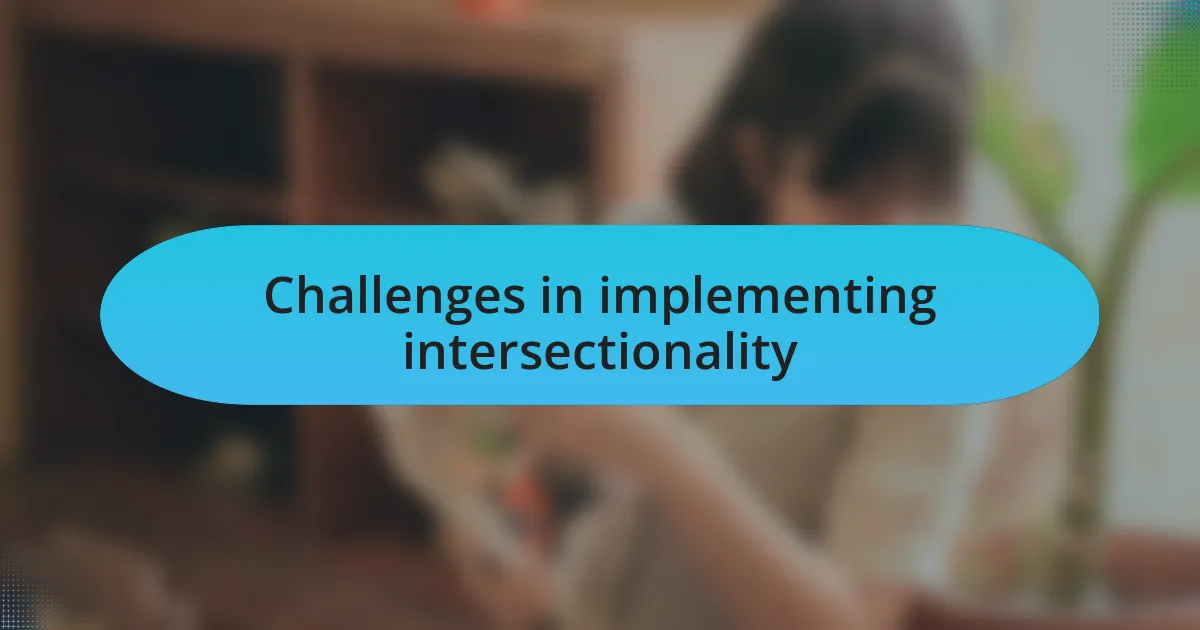Key takeaways:
- Intersectionality in advocacy recognizes that individuals experience discrimination through multiple, overlapping identities, necessitating a multifaceted approach to support.
- Effective advocacy includes creating spaces for dialogue, incorporating intersectional training, and forming partnerships with underrepresented communities to amplify diverse voices.
- Challenges such as resistance to acknowledging privilege, skewed narratives, and analysis paralysis highlight the complexities of implementing intersectionality in advocacy efforts.
- The future of student unions can focus on becoming hubs of intersectional advocacy, providing ongoing training and utilizing technology to enhance communication and inclusivity.

Understanding intersectionality in advocacy
Intersectionality in advocacy acknowledges that people don’t face discrimination through a single lens, but rather through multiple, intersecting identities. I remember a friend from college who, despite being an exceptional student, often felt marginalized due to her mixed-race background and her + identity. It made me realize how vital it is to understand the complexity of each person’s experience when we advocate for their rights.
Advocacy rooted in intersectionality not only recognizes these diverse experiences but also addresses the unique challenges that come with them. Have you ever considered how a single issue, like mental health, can be perceived differently based on one’s race, gender, or socioeconomic background? When I volunteered at a local mental health organization, I saw firsthand how cultural stigma varied widely and affected access to support services. This reinforced my belief that advocacy must be as multifaceted as the individuals we seek to support.
Incorporating intersectional perspectives into advocacy work can lead to more effective solutions and support systems. I often think about the importance of listening—truly listening— to those affected. It’s crucial to ask questions that illuminate the layers of identity involved in any situation and ensure that all voices are represented in the conversation, rather than imposing one-size-fits-all solutions.

Examples of intersectionality in practice
When I attended a workshop on disability rights advocacy, I was struck by the stories shared by individuals who navigated both physical disabilities and racial discrimination. One participant spoke about her struggle to find accessible job opportunities while also facing cultural stereotypes about her ethnicity. This highlighted how multiple barriers can compound, making it clear that our advocacy must address these interconnected challenges.
In another instance, during a community meeting focused on housing equity, I witnessed the intersection of gender and socioeconomic status. A single mother shared how the lack of affordable housing affected not just her own stability but also impacted her children’s educational opportunities. It made me realize that advocating for fair housing policies requires an understanding of how these issues intertwine with parental responsibilities and economic vulnerability.
I often reflect on how vital it is to amplify voices from diverse backgrounds. One colleague from the + community shared her experience of being excluded from health services catered to women, emphasizing the need for inclusive approaches that don’t overlook anyone’s identity. It’s a powerful reminder that our advocacy efforts must be informed by the complexities of people’s lives, as each individual’s story adds another layer to the understanding of intersectionality.

Strategies for inclusive advocacy
One effective strategy for inclusive advocacy is to create spaces for dialogue that welcomes diverse perspectives. I remember facilitating a focus group where we intentionally invited individuals from various backgrounds, including those from minority groups. The discussions became enriching as participants shared unique experiences that illuminated issues I had previously overlooked. It made me wonder: how often do we engage voices that challenge our assumptions?
Another key approach is to incorporate intersectional training within advocacy groups. During one workshop I attended, we learned about the importance of understanding each member’s personal context. Not only did it enhance our team dynamics, but it also encouraged us to think critically about our audience and the barriers they might face. It’s so crucial to ask ourselves, are we truly prepared to listen and learn?
Moreover, developing partnerships with organizations that represent underrepresented communities can be transformative. I once collaborated with a local immigrant rights group for an advocacy campaign. Seeing the innovative strategies they employed to navigate overlapping identities inspired me to rethink my approach. It highlighted the significance of coalition-building and reminded me that together, we can amplify every voice in the room and push for genuine change.

Personal experiences with intersectionality
Navigating my own identity has deeply shaped my understanding of intersectionality. I recall a time during my university years when I participated in a panel discussion about mental health and racial identity. As I shared my struggles, I noticed how my experiences resonated with others who had faced similar challenges, but from different angles. It made me realize how vital it is to explore these layers of identity to foster empathy and connection.
One particular instance stands out: I attended a multicultural festival where I encountered stories of students from various backgrounds. Each narrative revealed the unique challenges they faced, particularly at the intersections of gender, race, and social class. Listening to these voices was both enlightening and humbling, prompting me to reflect on how my privilege and life experiences shaped my perspective. How often do we consider the complexity behind someone’s story?
In my involvement with a student organization focused on social justice, I witnessed firsthand the impact of intersectional awareness. We organized a workshop aimed at discussing privilege and allyship, where participants explored their own identities. Many admitted they hadn’t previously considered how their own experiences intertwined with those of others. The honesty in those conversations encouraged me to delve deeper into my own assumptions and biases, reinforcing the idea that advocacy thrives in spaces where intersectionality is recognized and celebrated.

Challenges in implementing intersectionality
Implementing intersectionality in advocacy often encounters resistance, primarily due to entrenched attitudes and institutional barriers. I recall a workshop where we aimed to integrate intersectional perspectives into a larger campaign. The pushback from some participants highlighted a reluctance to acknowledge privilege, making it clear that fostering an inclusive conversation requires patience and persistence.
Another challenge I noticed is the potential for skewed narratives. For instance, during a discussion about gender equity, voices from the + community were often sidelined. It struck me that this oversight can lead to a hierarchy of identities, where some experiences overshadow others. How do we ensure that all voices are heard in a genuinely intersectional framework?
Moreover, the complexity of identity can lead to analysis paralysis. When I joined a planning committee for a campus event, we spent so much time debating how to address every possible intersection that we lost sight of our main goals. It struck me then: while it’s important to be thorough, there’s also a need for actionable steps. After all, how can we take meaningful action if we’re caught up in the theory of intersectionality rather than its practical application?

Future visions for student unions
Looking ahead, I envision student unions becoming more than just spaces for organizing; they can evolve into nuclei of intersectional advocacy. For instance, imagine a union where diverse groups collaborate on campaigns that reflect the experiences of all students, not just the majority. I remember when I witnessed a coalition form between various student organizations to address mental health disparities. It was inspiring to see how their combined voices brought attention to overlooked issues.
I also believe that future student unions should offer ongoing training in intersectionality for their members. Reflecting on my own experience, I once participated in a workshop on inclusive leadership that transformed my understanding of advocacy. Creating spaces where students can learn about and discuss their own privileges can encourage deeper empathy and cooperation among different groups. How can we cultivate a culture that prioritizes growth and understanding?
Moreover, it’s essential that student unions use technology to amplify their reach and impact. I often think about how digital platforms can facilitate dialogues across campuses, allowing marginalized voices to be heard even from a distance. By harnessing innovative communication tools, student unions could encourage diverse participation, ensuring that all students feel connected and valued, regardless of their circumstances. Isn’t it time we utilize every tool at our disposal to build a more inclusive future?